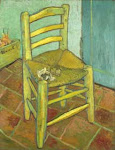Boston Globe writer Sebastian Smee has an insightful review online today of Yale University Art Gallery's dual display of "Starry Night" and "Cypresses." I've not seen YUAG's exhibit (sadly), but I've seen both those paintings in their regular homes (MoMA and the Met respectively) and my opinion is the same as Smee's: "Cypresses" is the more dynamic painting of the two. Smee characterizes "Starry Night" as feeling more like an experiment -- quite rightly, because despite its fame and icon status, "Starry Night" was atypical of van Gogh's oeuvre and not a piece that particularly stood out for him. It *was* an experiment, an abstraction done indoors when he was not able to go outside and do a proper night scene. (Being in the asylum of Saint-Rémy at the time and only allowed to roam the countryside during the day.) Vincent had experimented with abstractions -- in the sense of scenes done from his imagination, not from nature -- while Gauguin was staying with him in autumn 1888, but by this time had largely abandoned the method. "Starry Night" is an anomaly. "Cypresses" is much more the kind of painting Vincent enjoyed creating and is much more 'characteristic.' When I had my research fellowship at the Met some years ago and would make my pilgrimages to the van Goghs, "Cypresses" was one of those I liked the best, for its textures and sense of movement. You can *feel* the wind in the trees and grasses, and trust me, on a day of mistral, the air feels exactly that swirly.
If my blogstats are any indication -- I've been getting a LOT of Connecticut visitors this summer -- the YUAG show is doing very well. Any visitors want to share their experience? Is YUAG's own experiment of a two-painting exhibition, limiting the number of visitors so all can engage well with the pictures, successful?
Sunday, August 10, 2008
Subscribe to:
Post Comments (Atom)






No comments:
Post a Comment